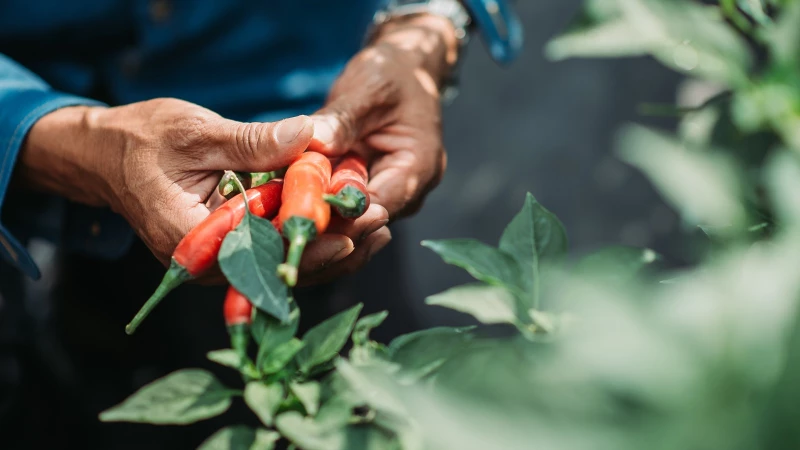If you want to add a little spice to your meals or enjoy the sweetness of peppers in your recipes, growing your own peppers can be a rewarding experience. Fortunately, it's not too difficult to cultivate your own peppers. But if you've had trouble growing peppers or if your plants aren't yielding as much as you'd like, some gardening tips could help. For those seeking quick and easy tips, look no further than TikTok. The platform is home to a lively gardening community full of innovative tricks and practical advice for successfully growing your pepper plants and troubleshooting any issues you may encounter. Some of the tips include using grow bags, using stakes for support, topping off your plants, and properly pruning or pinching them.
Grow Your Pepper Plants in Grow Bags
@nakedgardener topping pepper plants was scary at first but now it's my preferred method #peppertips #pepperplants #gardentips #gardentok #gardening #zone7b #northcarolina #nakedgardener #springplanting
♬ original sound - NakedGardener
Growing your pepper plants in grow bags offers a range of benefits. First, it reduces the likelihood of pests and protects your plants from diseases that may be in the soil. Additionally, in traditional containers, roots can become root-bound as they grow around and at the bottom of the container without air exposure, but this isn't a problem in grow bags. This is because they're made from breathable material that allows air to reach the roots, promoting a healthier root system by naturally drying them out. Pepper plants are also very sensitive to overwatering, but the excellent drainage from a grow bag's sides and bottom significantly reduces the risk of this.
Use plant stakes for support
While you don't need to stake your pepper plants when they're young and small, this step becomes more beneficial as they grow taller. How tall they will grow depends on the variety of your pepper plant, but they may grow from 1 to 10 feet in height, with the average being about 3 to 4 feet tall. Pepper plants typically grow upwards and can get top-heavy as they bear fruit. Using stakes can help support their branches, preventing them from breaking under the weight of the peppers. At the same time, not all pepper varieties need support. Heavy pepper varieties, like bell peppers, will need to be staked, as well as other top-heavy varieties like habaneros and ghosts.
If you're looking to provide support for your plants, there are various options you can consider. You can use simple skewers or repurpose fallen tree branches from your garden as stakes. However, if your plants require more robust support, metal stakes might be a better choice. For example, a pack of 25 garden stakes available on Amazon has an inner metal pole with a plastic exterior coating, coming in different sizes to accommodate different plants. These stakes can be attached to your plants using twine or garden clips. Alternatively, you could repurpose small tomato cages to provide support for your pepper plants.
Top off your pepper plants
Plants focus their energy on growing tips, known as apical meristems. Typically, their primary growth occurs at the shoot tip rather than in the axillary buds, which are the buds on the side branches. Topping is a gardening technique where you prune the top of the plant to encourage growth from the axillary buds. This results in the plant growing wider and bushier, ultimately leading to increased yields. Additionally, topping helps the plant focus more energy on its main stem, making it stronger.
However, thehomesteadingrd shares that not everyone should use the technique of topping pepper plants, and there are common mistakes to avoid. This method is most suitable for smaller pepper plant varieties and should be performed when the plants are less than 8 inches tall. It is more effective for plants cultivated in warmer climates with longer growing seasons. Timing is crucial as topping can delay the harvest, and you wouldn't want your peppers to start producing fruit close to the winter season.
If you decide that topping is the right choice for your pepper plants, make sure not to discard the removed leaves. You can incorporate them into a salad, stir-fry, or use them as a garnish. Additionally, you can easily propagate them by placing the cut branches in a glass of water, ensuring at least one node is submerged, as demonstrated by sunshinefarmny.
Other pruning and pinching tips
Pruning and pinching are essential gardening techniques for maximizing the productivity of your pepper plants. If your goal is to boost fruit production, consider following the advice of texasgardenguy by pruning the lower branches and leaves of your pepper plant. This practice helps the plant channel its energy towards fruit growth, shields it from ground-based pests and diseases, and enhances air circulation for overall plant health. Another approach, shared by farmerya, involves removing lower leaves once the pepper plant starts flowering. By doing so, the plant can allocate more resources to developing larger fruits, a helpful TikTok tip for growing bigger bell peppers.
On the contrary, azzengarden recommends pinching off flowers if you want your plant to prioritize root system and foliage growth. While harvesting fruits is rewarding, in regions with extended warm seasons and quick-maturing pepper varieties, encouraging deeper root development can fortify the plant for a bountiful harvest later on. This practice can be carried out before and a few weeks after transplanting, allowing the plant to establish a robust root system in its new environment. If you're uncertain about transplanting your pepper plants, here's a guide on the best way to ensure a successful and fruitful relocation.







